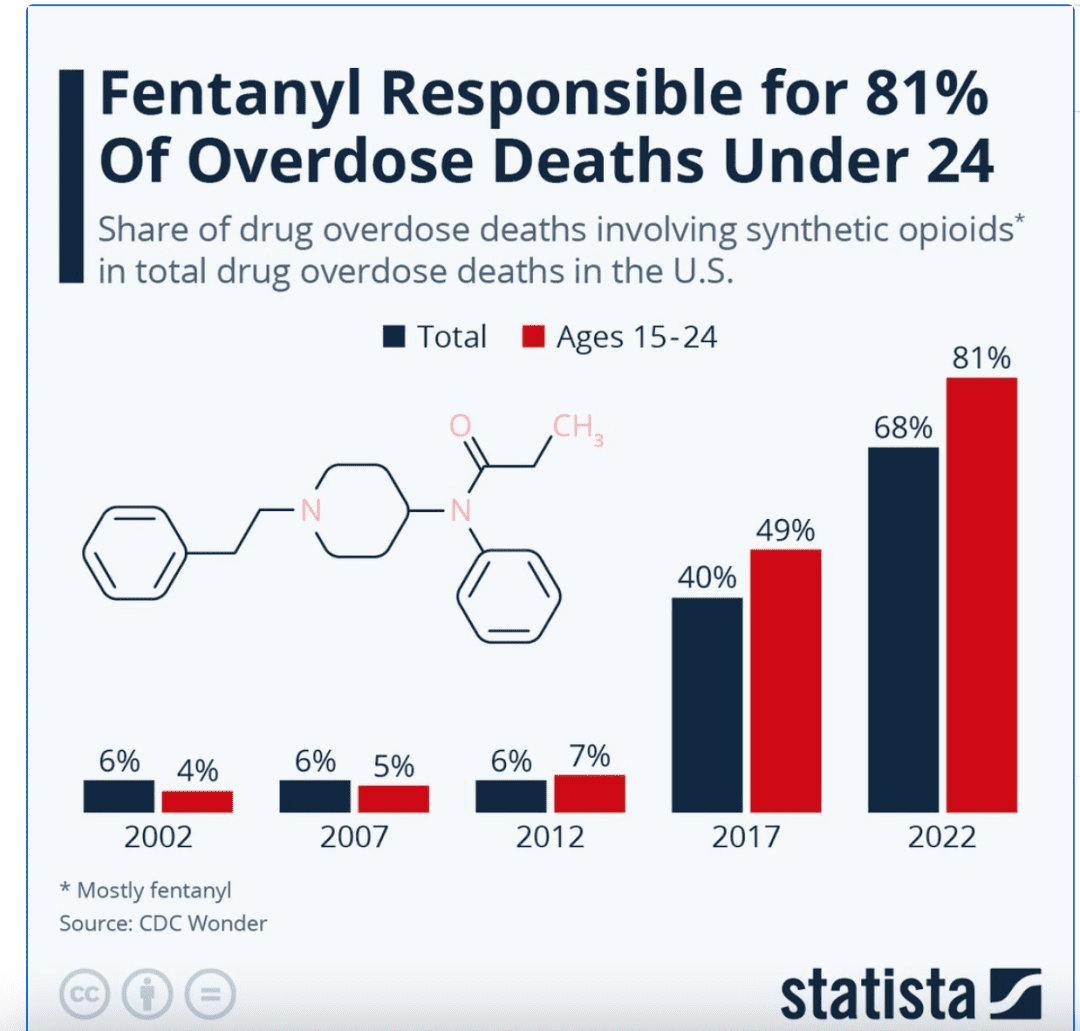Recent data from the Centers for Disease Control and Prevention shows that fentanyl overdose is responsible for 81% of drug overdose deaths in people under the age of 24. This potent synthetic opioid has rapidly spread throughout the illicit drug market, and overdose deaths have spiked in turn.

Perhaps the most concerning part of this information is the rate at which these deaths happen in young people. Adolescents and young adults struggling with substance use disorders face immense danger from fentanyl, and finding an evidence-based recovery program can help them break their addiction before this horrific outcome.
Fentanyl Overdose
Understanding the extremely high rates of fentanyl overdose deaths in young people requires looking at a number of factors. First, it’s important to recognize that fentanyl has only been in the drug supply for about a decade and that the opioid crisis has undergone three distinct waves, according to the CDC. These three waves include:
- A rise in prescription opioid overdose deaths in the 1990s and 2000s
- A surge in heroin overdose deaths starting in 2010
- A massive surge in fentanyl overdose deaths beginning in 2013
At first, fentanyl was considered a contaminant in the drug supply — something that was added to heroin to make it more potent. Yet, today, fentanyl is the opioid most people use and seek out, and heroin use has dropped dramatically in favor of this stronger, more potent opioid.
Additionally, the rate of overdose from other drugs, such as cocaine, methamphetamine, or benzodiazepines, has increased somewhat over the last ten years, but nowhere near the degree that fentanyl overdose deaths have spiked.
“Fentanyl is 100 times more potent than morphine and 50 times more potent than heroin.”
Third and finally, it’s important to understand why fentanyl use carries such a high risk of overdose. Fentanyl is exponentially stronger than other opioids, with the DEA estimating that fentanyl is 100 times more potent than morphine and 50 times more potent than heroin.
The lethal dose of fentanyl is so small that it can be very easy for people to accidentally take too much, particularly when they don’t understand the strength or potency of the drug.
These three factors all contribute to the record drug overdose deaths over the last several years, increasing each year from 2018 to 2022. In 2022, the CDC reported 111,029 deaths by drug overdose of any kind, with 84,181 involving opioids, primarily fentanyl.
Are More Young People Using Opioids?
The precipitous rise of opioid overdose deaths may lead you to think that substance use among young people is on the rise. However, this is not necessarily the case. Data from the National Survey on Drug Use and Health shows that drug use among young people has remained relatively stable over the last several years.
This makes another important point clear — the rise in overdose deaths is not due to more young people using opioid drugs but, instead, because more people are overdosing on drugs due to the introduction of potent opioids such as fentanyl.
Why Has Fentanyl Become So Common in the Drug Supply?
There are several reasons that fentanyl has quickly overtaken the opioid market in the United States. When compared to a drug such as heroin, fentanyl is:
- Easier to manufacture
- Easier to smuggle into the country
- Harder for border patrol agents to detect
- More potent, meaning drug users need to use less to get the same effect
- Cheaper
Unlike heroin, fentanyl can be made entirely in a laboratory without requiring naturally sourced ingredients such as opium poppy. This has also led to people manufacturing fentanyl inside the United States rather than shipping it in from other countries.
Drug suppliers may also press fentanyl into pills designed to resemble prescription medications. Pills resembling prescription painkillers, such as OxyCodone or Roxicet, are often black-market fentanyl in disguise, deceiving substance users as to the actual drug they are taking.
Finally, substance users may prefer fentanyl to drugs such as heroin because it does not need to be injected to get the same euphoric rush. The vast majority of fentanyl users smoke the drug rather than using a needle, which can make the substance more easily accessible to inexperienced drug users.
How to Stop Fentanyl Overdose in Young Adults
Stopping drug overdose has been a critical component of public health policy over the last several years, and a number of different efforts have proven to be successful. This includes:
- Narcan (Naloxone) nasal sprays: These single-use nasal sprays can usually reverse a fentanyl overdose if administered right away and are often carried by police, firefighters, or paramedics
- Fentanyl test strips: Since fentanyl is often found contaminating other drugs, fentanyl test strips can identify if any fentanyl is present in a drug purchased on the street
- Addiction treatment: Starting addiction treatment is the surest way of preventing people with substance use disorders from experiencing an overdose
These three strategies can dramatically reduce the rate of fentanyl overdose in young adults.
Finding Treatment With Never Alone Recovery
Never Alone Recovery can connect you with addiction recovery consultants and insurance-approved rehabs that can provide you with targeted, evidence-based addiction treatment services.
Call our team today at 866-788-8335 to have Never Alone Recovery connect you with an addiction treatment program and get the help you need to overcome a substance use disorder once and for all.


We're On Medium!
We're sharing the recovery stories of our community members. Be sure to check out Never Alone Recovery on Medium to read those featured stories.
YOU MAY ALSO LIKE...
July 2, 2024
March 8, 2022
December 26, 2023
December 12, 2022
June 18, 2024
DISCUSSION